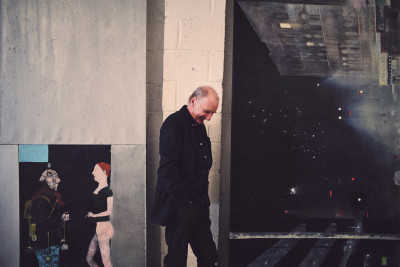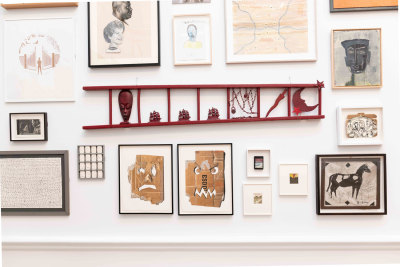10 minutes with… Richard Wilson RA
10 minutes with… Richard Wilson RA
By Harriet Baker
Published 23 December 2014
Each month, we have a quick chat with one of our Academicians to find out what they’re up to and what the RA means to them.
-
Richard Wilson is best known for his seminal installation 20:50 (1987), a sea of reflective sump oil, which is permanently installed in the Saatchi Collection. Drawing heavily on engineering and construction practice for inspiration, he intervenes with architectural space throughout his critically acclaimed work. He works from his studio in Bermondsey.
-
What are you working on at the moment?
I’m always working on a number of projects in any one year. Currently I’m working on an RA exhibition in Hong Kong at the Peninsula Hotel, as part of Art Basel Hong Kong. It’s been established through the hotel and through the RA’s director of artistic programmes Tim Marlow, who as you know was previously the director of White Cube. He and Tracey Emin worked on a project for White Cube, and now he’s doing it with RAs.
I’m also working on a big solo exhibition in London as part of SohoCreate. I’ve been given the old Central Saint Martins art school on Charing Cross Road. It’s derelict, but it’s a different type of space to exhibit in. It’s a big project. It’s going to be an unusual show for me because it’s all small object-based work.
At the moment there are five projects going on and the phone rings all the time. I don’t have an actual in-house team, though I’ve just moved studio and then I will be putting together a small team for model making. Usually, I instigate the ideas and then they go out to engineering firms.
I don’t usually work with an in-house team because I like the solitude when I’m playing around with ideas. I’m very good company for myself and I can get a lot done on my own. When I have to keep other people going it takes up a lot of my thinking time because I’m distracted with organising them. By contracting the work out I don’t have to hover over it and watch it. I can visit and take a look at it, but then I’m back to my ideas. It’s a practicality – I delegate!
-
What is your earliest memory of art?
My grandfather was an artist, Robert Wilson, and I remember when we were very young kids and our parents went away, that we would go and stay with my grandfather. I remember the smell of the house; it was linseed oil. I was mesmerised because he had a studio in his living room where he lived in Earl’s Court, and he would sit there with his palette knife and jars of coloured pigments.
He had this enormous slab of stone and he would spoon out lapis lazuli blue and then pour oil over the top of it. He had a particular way of holding the knife, and there would be hours and hours of moving the oil over the paint, sticking and glitching. It seemed to take all day. It was a magical transformation of various bits into one solution.
He could have had someone else to do it for him, I suppose. But for him, it was a meditation on what he might be painting. The process of mixing the paint allowed him thinking time. He was thinking of what the future of that colour might be. I used to see him get pigment on the carpet and just leave it there and I’d think, “He’s making such a mess!” But this freedom to experiment and create really made an impression on me.
-

Richard Wilson with his sculpture Slipstream at Heathrow's new Terminal 2 The Queen's Terminal
Photographer: David Levene. Image courtesy of the artist
-
What work of art do you wish you’d made?
In once sense I think I’ve already made it because I did so well out of 20:50. When I made it in 1987 there was such an explosion. You can go round the world and most people who are versed in the grammar of art know about the piece.
Having said that I wrote an article several years ago for The Guardian and it was about Barry Flanagan’s work, A hole in the sea (1969). It was a land art piece he did in Holland, and the last sentence of my article was, “I knew it was a great piece of work, because I wish I’d made it.”
I thought it was a genius piece in its simplicity but also as a statement of reclamation. It was action, performance, sculpture, site-specificity but it wasn’t premeditated. It was contemporary for its time. So perhaps that’s it. Seeing the work of someone else, when it’s brilliant, can energise you to get back into the studio and start making something again.
-
How do you know when a piece of work is finished?
You can’t overwork an idea: the moment just before a work is finished, it’s finished. It’s a fine balance. You almost want to finish it and then unpick it a bit as if it’s almost unlucky to finish it perfectly. You want a bit of nervous twitching, a bit of tension, in the sculpture.
-
Where were you when you found out that you had been elected?
Bill Woodrow RA phoned me and said, “Hey man, congratulations, you’re an RA.” But I didn’t know what it meant! But I thought I should throw myself into it to work out what it was all about. I came to understand everything about the RA, from the geography of what’s behind the gallery space to understanding the principles of how everything works here.
-

Richard Wilson, 20:50, 1987
Image courtesy of the artist
-
What does the RA mean to you?
Free booze, free books, free food, free club. It’s a damn good pat on the back for your career, and it’s good for socialising and making connections with other artists that you may not have otherwise had the chance to meet.
But more seriously, I think when you become an RA you become an ambassador for this wonderful institution. You carry forward its history and you represent it when you exhibit abroad. People are always curious about the RA.
-
If you were president for the day what would you change?
Being a sculptor, one thing I would like to do would be to make the courtyard a roofed atrium for sculpture, the prime space for a sculpture yard in London. People walk up and down Piccadilly and they can see the courtyard, but if there’s nothing there then they don’t go in. It would house group and solo sculpture shows and in the summer it could open up and be a beautiful space to see sculpture. It would be somewhere between public and private, inviting people into the RA.





